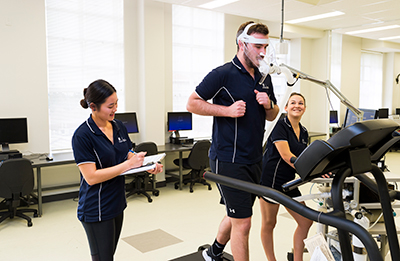The exercise that will maximise your heart and brain health
By Candy Gibson
> New evidence that exercise combats depression
 Human Movement, Occupational Therapy and Physiotherapy students Ashleigh Clark, James Fox and Katy Phan in the Exercise Physiology laboratory.
Human Movement, Occupational Therapy and Physiotherapy students Ashleigh Clark, James Fox and Katy Phan in the Exercise Physiology laboratory.New research has revealed the exercise regime that gives both the heart and brain the best workout.
It appears the brain derives substantial benefits from both high intensity interval training and longer, continuous bouts of moderate exercise. Cycling or running at full speed without mixing up the tempo may elevate the stress hormone, cortisol, blocking the positive effects.
The findings are based on multiple experiments involving 128 people whose brains were monitored after a single bout of aerobic exercise on a stationary bike and treadmill, ranging from low intensity continuous exercise to high intensity interval exercise, with the heart rate varying between 50 to 90 per cent intensity.
UniSA researcher Dr Ashleigh Smith and her PhD student Maddison Mellow found that the greatest changes in neuroplasticity – the brain’s ability to rewire or modify its neural connections – occurred with 20 minutes of interval training or 25 minutes of continuous moderate aerobic exercise.
“We already know that engaging in regular aerobic exercise is good for the brain, improving memory, attention and learning,” says Dr Smith. “However, we need to understand why it is so beneficial and what the best exercise, intensity and duration is.”
Mellow says neuroplasticity drives the brain’s development, from infancy to adulthood, helping to learn new skills, form memories and recover from brain injuries or stroke.
“Long-term studies demonstrate that people who engage in regular exercise show greater neural connectivity that those who are sedentary. Research also shows that exercising before learning a new motor skill can help a person learn it much faster,” Mellow says.
Cortisol appears to play a major role in whether an exercise is mentally beneficial. High levels block neuroplastic responses, yet interval training may allow a sweet spot for cortisol rates to return to normal levels, the researchers say.
“What makes the brain special is that, unlike a computer, it processes sensory and motor signals in parallel,” Dr Smith says. “It has many neural pathways that can replicate another’s function so that if the brain is damaged it can re-route signals along a different pathway. The more elastic the brain, the easier this is.”
The researchers’ findings have been published in the Journal of Science and Medicine in Sport.
New evidence that exercise combats depression
By Annabel Mansfield
From a friendly game of soccer to sweating it solo in the gym, most of us know that exercise is good for our health but research led by a UniSA academic has provided more evidence that exercise can also protect us from developing serious mental health disorders.
In a study, UniSA expert in sports sociology Dr Katja Siefken and colleagues at the MSH Medical School Hamburg, assessed levels of anxiety and depression among 682 German recreational athletes under different sport conditions (amount and intensity), settings (indoor vs outdoors) and contexts (individual or team sports), finding that people who exercise less than 2.5 hours a week are at risk of increased anxiety and depression.
The research indicates that athletes who meet the World Health Organization’s (WHO) exercise guidelines (150 minutes moderate-intensity physical activity throughout the week for healthy adults aged 18-64 years) have a better mental health status than those who are less active.
Dr Katja Siefken says the findings provide valuable insights for mental health, particularly as mental health is often disregarded in public health recommendations.
“Mental health disorders are one of the most significant health challenges of our time, contributing substantially to the burden of global disease,” Dr Siefken says.
“Exercise is a key part of building and retaining both physical and positive mental health, but it’s important to recognise that different exercise conditions can affect mental health in different ways.
“Understanding the factors that can influence or alleviate depression and anxiety are essential, but until now, there’s been insufficient proof about the optimal types – or amounts – of activity needed for positive mental health.
“In this study, we found that people who did not meet physical activity recommendations, reported higher depression scores, independent of whether they practised indoors or outdoors, individual, or in a team.
“We also found that the lowest depression and anxiety scores mostly occurred among indoor team athletes but that athletes undertaking vigorous-intensity physical exercise often recorded higher levels of depression.
“There is also good evidence that outdoor exercise contributes to improved mental health and that doing sports together, or as part of a team, may positively impact our mental health substantially.
“So, it's really a case of monitoring physical and mental capabilities on an indivdiual basis. And, while we often hear the phrase 'the more exercise, the better' – evidence shows this is far more complex.
"A healthy mind and body rely upon modest, achievable levels of physical exercise. For most of us, two-and-a-half hours a week – or, say 30 minutes a day over five days – is a reasonable ask to encourage positive mental health.”
Other Stories
- The exercise that will maximise your heart and brain health
- What is the language of love in the 21st century?
- How to take a tiger’s pulse with a digital camera
- Graduates’ visual handiwork on show for the Oscars
- From the Vice Chancellor
- Achievements and Announcements
- Video: Helping nature recover after Cudlee Creek bushfire
- UniSA offers video gamers a chance to realise their dream jobs
- Students tackle some of life’s big questions in new MOD. podcast
- College graduate returns behind teacher’s desk
- Honouring the ‘voice of cycling’
- Swedish internship gives UniSA students a headstart in defence careers
- Project unearths silent witnesses to history
- Bushfire fundraiser, TDU and more




